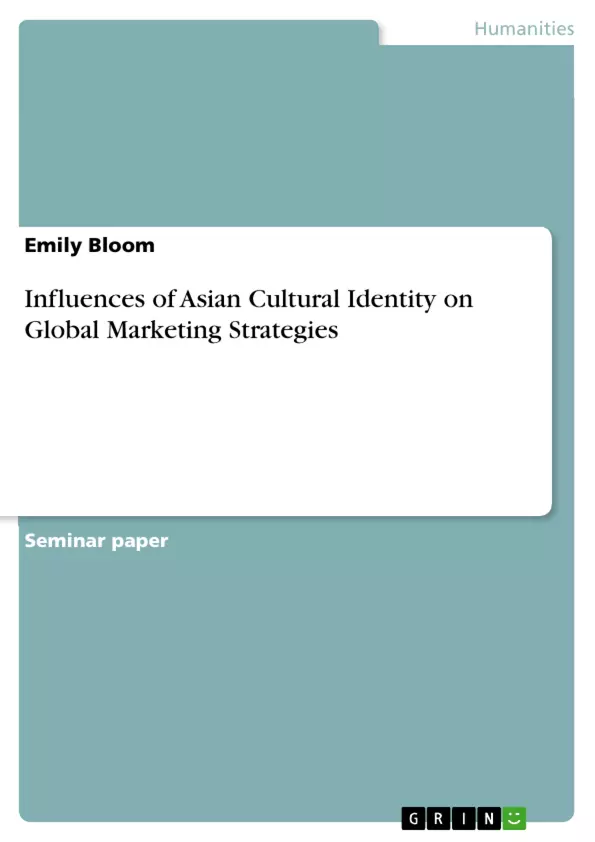This paper discusses the influence of Asian cultural identity on Global Marketing. Over the course of the past decades globalisation has had a great impact on the every day lives of people around the globe. Due to the advances in technology and new inventions, such as the internet and therefore the diminishing of boundaries, people from various countries of the world are now more than ever able to be connected to each other, travel and overcome far distances, as well as purchase and consume products and services from all over the world.
The benefits of globalisation not only influence people in their daily lifes, but can also be applied to the way in which companies organise themselves as well as operate in their home and foreign markets. The rise of global companies that sell and market products in foreign countries affected organisational work and created the need for global marketing strategies. In order for these strategies to work the different cultural backgrounds and values of customers need to be taken into account. Mooij supports this idea by pointing out, that in order for marketing or advertising to be effective it “must include values that match the values of the consumers being addressed“ (Mooij, 1998, p.91). Mooij explains further, that the way in which consumers behave and are motivated largely depends on their culture, which is why marketing strategies need to be relevant to the culture of the consumer they are trying to address (Mooij M. D., 1998). This explains why marketing managers today face a number of challenges and are influenced by the cultural identity of the country they are marketing a product in.
Asia has one of the largest economies of the world which makes it extremely attractive for companies seeking to expand globally. East Asia alone is home to about 20 percent of the world’s population and is likely to make up an equally high share of the world trade (Chaze, 2010). In the following, this essay will try to explain how the Asian culture in terms of group, family and status orientation might culturally influence the way in which foreign companies market their products to Asian consumers as well as discuss possible practical measures that should be taken by international marketers in this context.
Inhaltsverzeichnis (Table of Contents)
- Introduction
- The Asian Cultural Framework and Its Influence on Global Marketing
- Collectivist Asia and The Importance of Family
- Uncertainty Avoidance and The Concept of “Face”
- Power Distance and Social Status
- Masculinity versus Femininity
- Marketing Communication in Asia
- Practical Measures for Global Marketers
- The Hard-Sell versus Soft-Sell Approach and International Marketing Research
- Segmentation and Changing Cultural Values
- Discussion Part
- Conclusion
Zielsetzung und Themenschwerpunkte (Objectives and Key Themes)
This essay explores the impact of Asian cultural frameworks on global marketing strategies, particularly focusing on how cultural values influence consumer behavior and how companies can effectively market their products in this context. It aims to provide practical insights for marketers seeking to expand into Asian markets.
- The influence of Asian cultural values, such as collectivism, uncertainty avoidance, and power distance, on consumer behavior.
- The importance of understanding and adapting marketing strategies to the unique communication styles and cultural nuances of Asian consumers.
- The impact of changing cultural values within Asian markets, such as the rise of individualism among younger generations, on global marketing.
- The need for culturally sensitive approaches to marketing, such as market segmentation, to effectively target diverse consumer groups within Asia.
- The significance of international marketing research and its role in tailoring marketing strategies to the specific needs and preferences of Asian consumers.
Zusammenfassung der Kapitel (Chapter Summaries)
The introduction highlights the growing importance of global marketing in a world increasingly connected by technology. It emphasizes the need for marketers to consider cultural differences and values when developing their strategies.
Chapter 2 delves into the Asian cultural framework, drawing upon Hofstede’s five dimensions of culture theory and Hall's high-context and low-context culture theory. It examines the impact of collectivism, uncertainty avoidance, power distance, and masculinity versus femininity on consumer behavior. It also discusses the significance of the concept of “face” in Asian cultures.
Chapter 3 presents practical measures for global marketers, focusing on the hard-sell versus soft-sell approach and international marketing research. It explores the importance of segmentation and the evolving cultural values of younger Asian consumers, particularly the “Dusheng” generation.
The discussion part emphasizes the need for cultural awareness and sensitivity in global marketing. It highlights the importance of acknowledging cultural diversity and recognizing the individual differences within Asian markets.
Schlüsselwörter (Keywords)
This essay explores the crucial role of cultural frameworks in global marketing, specifically focusing on the Asian market. Key themes include collectivism, uncertainty avoidance, power distance, high-context culture, “face”, marketing communication, segmentation, and international market research. The essay highlights the need for culturally sensitive approaches in marketing to effectively reach diverse Asian consumer groups and adapt strategies to changing cultural values.
- Quote paper
- Emily Bloom (Author), 2014, Influences of Asian Cultural Identity on Global Marketing Strategies, Munich, GRIN Verlag, https://www.grin.com/document/309498



